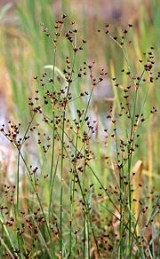
Juncus articulatus
Encyclopedia
Juncus articulatus is a species of rush
known by the common name Jointleaf Rush, and more ambiguously as "Jointed Rush" which can also refer to J. kraussii
from Australia
. It is native to Eurasia and much of Canada and the United States. It grows in moist areas, such as wet sand, and thrives in calcareous
soils. This is a perennial herb producing a mainly erect stem from a short rhizome
. The stem may root at nodes, and it generally has one or more cylindrical leaves up to 10 centimeters long.
The inflorescence
atop the stem has several branches with up to 25 clusters of up to 12 flowers each. Each individual flower has greenish to dark brown, pointed tepal
s 2 to 3 millimeters long, six stamen
s bearing anthers, and a protruding, feathery pistil
. The fruit is a dark brown capsule with a pointed tip.
Horizontal internal joints may be seen or felt on the stem of the plant.
Juncus
Juncus is a genus in the plant family Juncaceae. It consists of some 200 to 300 or more species of grassy plants commonly called rushes...
known by the common name Jointleaf Rush, and more ambiguously as "Jointed Rush" which can also refer to J. kraussii
Juncus kraussii
Juncus kraussii is a species of rush known by the common name Jointed Rush. It is native to temperate coastlines and estuaries of Australia flowering year round.-External links:*...
from Australia
Australia
Australia , officially the Commonwealth of Australia, is a country in the Southern Hemisphere comprising the mainland of the Australian continent, the island of Tasmania, and numerous smaller islands in the Indian and Pacific Oceans. It is the world's sixth-largest country by total area...
. It is native to Eurasia and much of Canada and the United States. It grows in moist areas, such as wet sand, and thrives in calcareous
Calcium carbonate
Calcium carbonate is a chemical compound with the formula CaCO3. It is a common substance found in rocks in all parts of the world, and is the main component of shells of marine organisms, snails, coal balls, pearls, and eggshells. Calcium carbonate is the active ingredient in agricultural lime,...
soils. This is a perennial herb producing a mainly erect stem from a short rhizome
Rhizome
In botany and dendrology, a rhizome is a characteristically horizontal stem of a plant that is usually found underground, often sending out roots and shoots from its nodes...
. The stem may root at nodes, and it generally has one or more cylindrical leaves up to 10 centimeters long.
The inflorescence
Inflorescence
An inflorescence is a group or cluster of flowers arranged on a stem that is composed of a main branch or a complicated arrangement of branches. Strictly, it is the part of the shoot of seed plants where flowers are formed and which is accordingly modified...
atop the stem has several branches with up to 25 clusters of up to 12 flowers each. Each individual flower has greenish to dark brown, pointed tepal
Tepal
Tepals are elements of the perianth, or outer part of a flower, which include the petals or sepals. The term tepal is more often applied specifically when all segments of the perianth are of similar shape and color, or undifferentiated, which is called perigone...
s 2 to 3 millimeters long, six stamen
Stamen
The stamen is the pollen producing reproductive organ of a flower...
s bearing anthers, and a protruding, feathery pistil
Gynoecium
Gynoecium is most commonly used as a collective term for all carpels in a flower. A carpel is the ovule and seed producing reproductive organ in flowering plants. Carpels are derived from ovule-bearing leaves which evolved to form a closed structure containing the ovules...
. The fruit is a dark brown capsule with a pointed tip.
Horizontal internal joints may be seen or felt on the stem of the plant.

